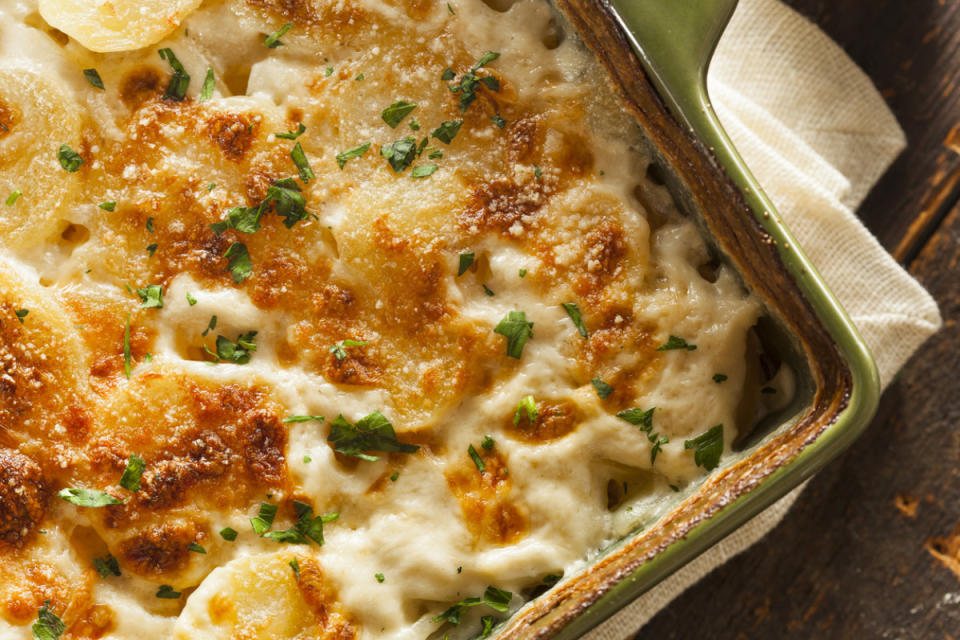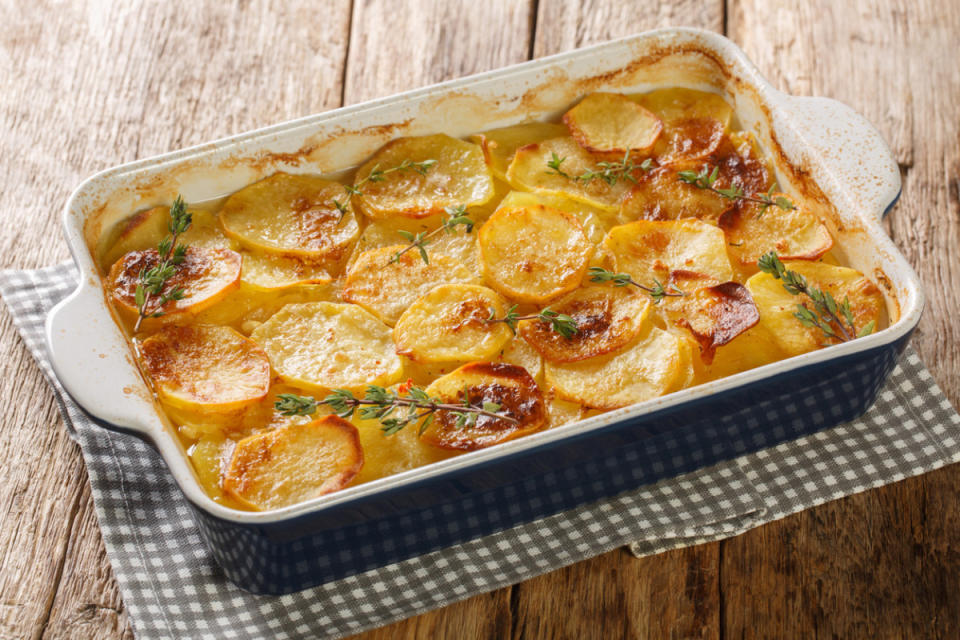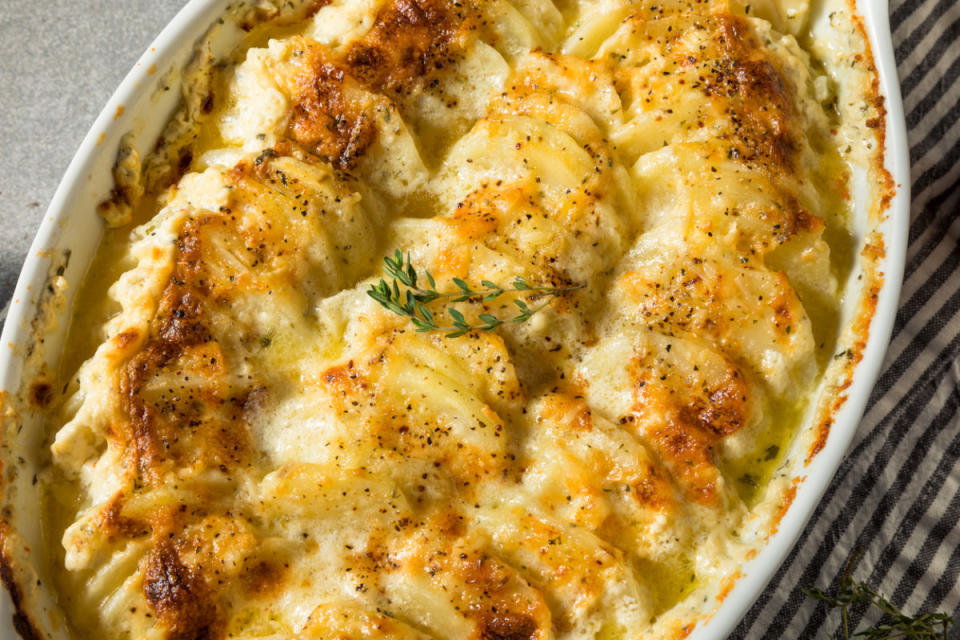Wait, What's the Difference Between Scalloped Potatoes and Potatoes Au Gratin?

Scalloped vs. au gratin potatoes
Puh-tay-tow, Pah-tah-tow? When it comes to pronouncing potato, you do you. The versatile carbohydrate is perfect for soups, stews and meals in general. Mash or bake 'em or serve them scalloped or au gratin—indeed, it's hard to go wrong.
Yet, au gratin and scalloped potatoes are sometimes used interchangeably—and are both delicious served alongside a holiday ham—so what's the difference between the two?
"Scalloped potatoes and au gratin are similar in that they are both thinly sliced potatoes that are layered and cooked with cream," explains Mike Dilonno, the chef and owner of Beggars Banquet in New Orleans. "Their appearance is the same because they usually are both baked in casserole dishes and come out bubbly and golden brown."
However, unlike pronunciations of potato, scalloped and au gratin mean different things. What's the difference between scalloped and au gratin potatoes? Chefs cut through the confusion and explain, plus offer their best potato-pairing tips.
Related: I’m a Chef and My Wife Says My Extra Crispy Roasted Potatoes Changed Her Life

iStock
Scalloped Potatoes vs. Au Gratin Potatoes: What's The Difference?
There are a few subtle distinctions between scalloped and au grain potatoes. The biggest? "Cheese," dishes Kevin Lee, the chef behind Birdies by Chef Kevin Lee in Oklahoma City. "Au Gratin is ooey-gooey deliciousness and scalloped potatoes are more delicately baked."
The delicate baking also has to do with some other ingredients that are (or aren't) mixed in.
"Scalloped potatoes are made with a flour-butter-milk roux, whereas au gratin potatoes are made with cream, butter and cheese, which are my personal favorite," explains William Muzio, the corporate executive chef with Lessing's Hospitality Group.
That distinction is important if you're hosting a person with gluten sensitivities (or have them yourself).
"Scalloped potatoes usually contain gluten, whereas au gratin potatoes are typically gluten-free because they are held together by cream and cheese," Muzio explains.
Dilonno adds that au gratin potatoes are usually more thinly sliced, though both dishes will feature potatoes cut into rounds.
The origins of the terms are also different.
"My whole life, I thought it was scalloped because the potatoes were sliced in a scallop-shaped way," Lee says. Then, I learned it actually originated from an old English word, collop, which means sliced. You learn something new every day."
As for au gratin, "Au gratin means 'by grating' in French," Lee says. "For the culinary definition, some people say this refers to the 'grated' cheese used in the dish, but others say the origin is really from the verb 'gratinee,' which means to give a dish a golden brown top."
Consider these nuggets of information part of your dinner-party conversation.
Related: Martha Stewart's Super-Simple Tip Will Give You the Fluffiest Baked Potato Ever

iStock
How Do You Make Scalloped Potatoes?
As Muzio explained, scalloped potatoes use a flour-butter-milk mixture. Lee says recipes also often call for heavy cream, and of course salt and pepper.
To cook scalloped potatoes, you layer thinly sliced potato rounds on top of this creamy mixture and bake until golden brown. Noticeably absent is the cheese, which some scalloped potato recipes may call for, but know that the addition of cheese deviates from the traditional scalloped potato definition. (This occasional cheese addition is also why these two terms are often used interchangeably.)
Muzio and Dilonno suggest serving scalloped potatoes as a side dish to more straightforward proteins.
"Think springtime and lighter flavors — a pan-roasted fish," Muzio says.
Related: My Chef-Husband Made Me His Marry Me Potatoes and I Would Definitely Say 'I Do' All Over Again

iStock
How Do You Make Au Gratin Potatoes?
Dilonno suggests starting by thinly slicing Russet or Yukon Gold potatoes.
"Layer them in a casserole dish with grated Gruyère, cheddar or another rich cheese with a cream-based sauce," Dilonno says. "Then, bake until potatoes are cooked and a crust forms that’s golden brown. You can also sprinkle with bread crumbs if you want to add an extra crust, although I like them simply prepared."
Dilonno likes to serve potatoes au gratin with something hearty, like duck or red meat.
Related: 12 Best Potato Side Dishes
What’s the Difference Between Au Gratin and Gratin Potatoes?
We've got one last "what's-in-a-name" score to settle. Like scalloped and au gratin potatoes, these terms are often used interchangeably. Is it warranted in this case? Once again, home chefs will want to be aware of some differences, and we'll refer back to the translation for 'au gratin.'
"In cooking, the word 'gratin' refers to a dish with a lightly browned crust of breadcrumbs or melted cheese," Dilonno says. "'Au gratin' means 'by grating' in French or 'with a crust' and usually refers to a casserole covered in browned breadcrumbs and cheese."
If you're confused, allow us to translate. "Gratin" is any dish that's topped with cheese or breadcrumbs mixed with butter, whether there are potatoes under there or not. "Au gratin" is the method of cooking a dish in the manner of a gratin. TL; DR: Everyday cooks can use either term. If you're hanging out with chefs, things might get a little nerdier, but now you know.
Related: The Roasted Potatoes Everyone Will Be Talking About
Sources
Mike Dilonno, the chef and owner of Beggars Banquet in New Orleans
Kevin Lee, chef at Birdies by Chef Kevin Lee in Oklahoma City
William Muzio, corporate executive chef with Lessing's Hospitality Group
Up next: The Difference Between Rolled Oats and Quick Oats, According to the Experts at Bob's Red Mill
